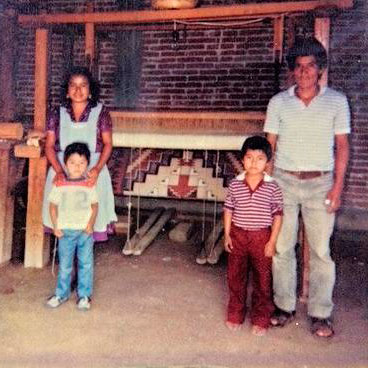WEAVING
THROUGH THE
GENERATIONS
As a boy, I remember sitting under my father’s loom as he wove. At first, I began working on the fringes of his weavings, tying the threads one at a time. Then as my passion for weaving grew, he would sit with me at his loom, and show me the rhythm and beauty of weaving.
That same passion I felt as a boy I still carry with me ― and I weave it into every piece I make.
So, too, my son and daughter have grown up sitting beneath my loom ― and just like me at that age, they are both eager to learn all that my wife and I can teach them about the art of weaving.
As they continue to grow, I know that one day Cynthia and David Bautista will be even more skillful than their mother and father.
We are proud of the tradition that we uphold together, and thankful for the opportunity to honor and add to that tradition with our work.

1988 – Nazaria, Miguel, Porfirio and Francisco.
LAND
OF THE GODS
Teotitlán del Valle is a small village in the foothills of the Sierra Juarez Mountains, located in the east of the Valles Centrales of Oaxaca, Mexico. Teotitlán is considered the first village founded by the Zapotecs around 1465, originally called “Xaquija,” which means “Celestial Constellation.” The name of Teotitlán comes from Nahuatl and means “Land of the Gods.”
Weaving in the region dates back to 500 B.C.E., when villages would pay tribute to the Aztecs with their first weavings using cotton and ixtle in backstrap looms. In 1535 Dominican missionaries introduced foot looms and sheep, and the new materials allowed villagers to improve their weavings.
It is from this tradition that my family and I work each time we sit at our loom.

